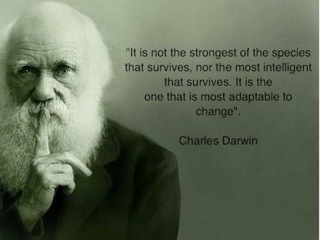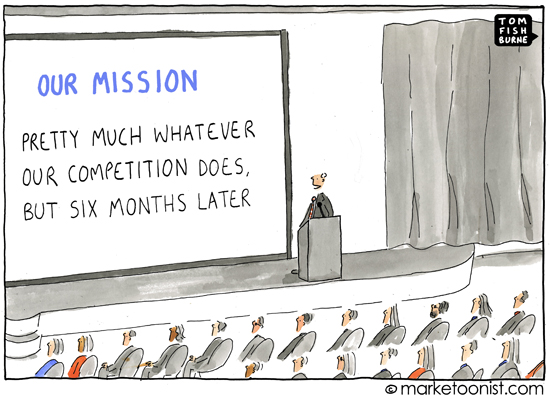http://www.patrickmckenna.com/blog
Page << Prev 20 21 22 23 24 25 26 27 28 29 Next >> of 95
Post #682 - Saturday, October 12, 2013
Is Law Firm Pedigree A Thing Of The Past?
Here is an interesting HBR blog post written by Dina Wang
and Firoz Dattu
 Have you ever heard the saying: “You never get fired for
buying IBM”? Every industry loves to
co-opt it; for example, in consulting, you’ll hear: “You never get fired for
hiring McKinsey.” In law, it’s often:
“You never get fired for hiring Cravath”.
But one general counsel we spoke with put a twist on the old saying, in
a way that reflects the turmoil and change that the legal industry is
undergoing. Here’s what he said: “I
would absolutely fire anyone on my team who hired Cravath.” While tongue in cheek, and surely subject to
exceptions, it reflects the reality that there is a growing body of legal work
that simply won’t be sent to the most pedigreed law firms, most typically
because GCsl are laser focused on value, namely quality and efficiency. Have you ever heard the saying: “You never get fired for
buying IBM”? Every industry loves to
co-opt it; for example, in consulting, you’ll hear: “You never get fired for
hiring McKinsey.” In law, it’s often:
“You never get fired for hiring Cravath”.
But one general counsel we spoke with put a twist on the old saying, in
a way that reflects the turmoil and change that the legal industry is
undergoing. Here’s what he said: “I
would absolutely fire anyone on my team who hired Cravath.” While tongue in cheek, and surely subject to
exceptions, it reflects the reality that there is a growing body of legal work
that simply won’t be sent to the most pedigreed law firms, most typically
because GCsl are laser focused on value, namely quality and efficiency.
A recent survey of General Counsel at 88 major companies
conducted by AdvanceLaw (an organization founded by Firoz) - The results
suggest that GCs are increasingly willing to move high-stakes work away from
the most pedigreed law firms (think the Cravaths and Skaddens of the world)… if
the value equation is right. (Firms surveyed included companies like Lenovo,
Vanguard, Shell, Google, NIKE, Walgreens, Dell, eBay, RBC, Panasonic, Nestle,
Progressive, Starwood, Intel, and Deutsche Bank.) The results of the two
questions the survey asked are below.
That 74% of GCs preferred the less pedigreed firm under the
circumstances described in question 1 reaffirms that clients are becoming more
and more comfortable with using a wider range of firms. Moreover, in the U.S., the current cost
premium for an AmLaw 20 firm relative to, say, an AmLaw 150 or 200 firm is
typically far more than 30%. Factoring
in lower hourly rates as well as the greater efficiency most clients say the
other firms deliver, we are likely talking about an overall cost premium in the
60+% range.
What can also seem non-intuitive is that only 11% of GCs
surveyed felt that pedigreed firms, despite the price premium, actually were
more responsive (a key element of client service). However, this actually mirrors Firoz’s
experience at AdvanceLaw, where firms of varying sizes and pedigree are
successfully unseating AmLaw 20 and Magic Circle incumbents on high stakes work
(e.g., a recent M&A deal valued at $500 million; national trial counsel for
a significant multi-state class action).
These firms have been receiving impressive evaluations from GCs and
in-house counsel on responsiveness, expertise, quality and efficiency. One reason for this is that top talent is
increasingly dispersed, not residing solely at the most pedigreed of firms.
This AdvanceLaw survey suggests that clients are serious
about moving high-stakes work away from the most pedigreed (and expensive) law
firms. So, are white shoe firms feeling
the impact of this mindset change? When
we examined revenue per lawyer (a proxy for a law firm’s ability to command a
price premium) across a sample of firms, we found that growth was highest among
non-pedigreed firms. Our sample of 15
especially highly reputed firms (including the likes of Cravath, Skadden, and
Sullivan) experienced an average increase of only 2.9% in revenue per lawyer
over the 5-year period from 2007-12. In
comparison, a sample of 15 smaller, comparatively less known firms posted
average growth in revenue per lawyer of 12.7% in the same period.
Surprisingly, many (though not all) pedigreed firms are
choosing to not yet compete on value, arguing that this would diminish their
future ability to compete for the shrinking pool of high-stakes / high-margin
work. However, as the survey and
financial analysis reveal, this ends up opening the door for other law firms
(as well as non-traditional providers) to slip in and chip away at what we all
once assumed were unassailable relationships between the most pedigreed law
firms and their clients.
Make no mistake: the competition for market share in the
legal space is tough and getting tougher.
What do you think?
Post #681 – Saturday,
September 21, 2013
Fall 2013 Issue of
International Review Is Now Available
 Here’s
my newest issue of International Review – an issue that I hope
contains a balanced blend of thoughtful insight and practical contributions on
law firm strategy and leadership. Here’s
my newest issue of International Review – an issue that I hope
contains a balanced blend of thoughtful insight and practical contributions on
law firm strategy and leadership.
I believe that my colleague Ed Reeser
and I were amongst the very first to start cautioning firms about the overuse
of lateral hiring, efficiency - at producing commodity work, and excessive
compensation spreads. These articles have been intended to warn good
firms among the AmLaw 100, 200 and below of the dangers that may lie ahead if
they pursue some of these same strategies and we are gratified by the
supportive responses we’ve received from many firm leaders. In this issue we continue on that same theme
with two articles, Efficiency Is Not The Competitive Advantage and Are You Developing A Star Culture? Our piece on Star Cultures received a lot of
attention throughout July and August in Texas Lawyer, the ABA, The Legal
Intelligencer, Law Technology News, and American Lawyer – where it ranked among
the top five “most viewed stories” on multiple web sites.
In
our First 100 Days program (see: first100daysmasterclass.com) we introduce new firm
leaders to the same personality assessment taken by Fortune 500 CEOs and
designed to identify their 'Dark Side' - a personalized assessment of those
strengths you possess that, when under extreme pressure or stress, can turn
into vulnerabilities. I am delighted to include an article, Exploring The Dark Side: When Firm Leaders
Overuse Their Strenghts that emanates from research conducted over the past
five years.
Finally, Competitive Plagiarism warns us of what
can happen if we consciously or inadvertently replicate the strategies that
others may be pursuing; The Hurdles To
Initiating Change offers a view on what might be holding back some firms
from being more innovative; and Conducting
Client Interviews draws upon the wisdom of some insightful clients as to
their expectations when law firms come looking for feedback.
As always, I sincerely hope
that you find some practical ideas, tips and techniques here that you can put
to use immediately. Please send me your observations,
critiques, comments and suggestions with respect to any of these articles. Click on the Cover to download your e-magazine copy.
Post #680 – Thursday,
September 5, 2013
Your 4 Leadership
Feedback Questions
 One particular firm
leader I know makes it a regular habit to ask his fellow partners for feebdack
on how he is leading. He tells me that
it only involves his asking four questions: One particular firm
leader I know makes it a regular habit to ask his fellow partners for feebdack
on how he is leading. He tells me that
it only involves his asking four questions:
1. What do you need more of from me?
2. What do you need less of from me?
3. What is it that I’m doing that you
would like me to stop doing . . . completely?
4. And what is it that I’m not doing at all, that you would like me to start doing?
It’s really that
simple! How sad it is that more leaders
don’t engage in this kind of feedback process.
Post #679 – Monday, August 19, 2013
Is This What Some In BigLaw Firms Have Evolved Into?
 One of my colleagues had a talk with a former BigLaw
partner. He told of bully boy leadership, with a managing partner taking
$17 million a year in compensation (about 60 times the lowest paid partners at
$285k) and surrounding himself with people who get paid far more than they
contribute, but will do anything he asks to keep their rich sinecure.
Those who squeak, or even have the temerity to ask questions, are quickly
eliminated. Withdrawn / ejected partners wait interminably for the
capital return. (After several years this partner has only received about
20% of his capital back). One of my colleagues had a talk with a former BigLaw
partner. He told of bully boy leadership, with a managing partner taking
$17 million a year in compensation (about 60 times the lowest paid partners at
$285k) and surrounding himself with people who get paid far more than they
contribute, but will do anything he asks to keep their rich sinecure.
Those who squeak, or even have the temerity to ask questions, are quickly
eliminated. Withdrawn / ejected partners wait interminably for the
capital return. (After several years this partner has only received about
20% of his capital back).
Meanwhile, verein members do not cooperate with one
another but instead are run as independent fiefdoms that actually compete
against each other. The stuff going on as reported makes Dewey look like
a much nicer place to work. Heaven only knows if the verein component is
being manipulated only to pull more admin money for 'leader'
compensation.
But that's not all . . . people who are 'invited' to be partners are given a
signature page, but no copy of the actual partnership agreement. "Pending" partners, those who go
through a mandatory two to three year vetting or prove up, are required to put
up a deposit of capital during that period, which amount will then be credited
towards the capital obligation when and if they are made equity partner. (If
you don't put it up, you are told to leave). So equity from non-equity
people, but characterized not as equity and just a 'prepay deposit' towards
partnership capital. It would be interesting to know how that is treated
on the financials.
Is this merely the malicious ranting of some malcontent, former
BigLaw partner or the signs of a slow simmering problem moving towards full
boil?
Post #678 – Friday, August 9, 2013
Are You Daring To Fail?
“So what new initiatives did you tackle, during the past
twelve months, that didn’t exactly prove to be as fruitful as you might have
wished?” And if your answer is, “none.” Then what does that tell you? It may suggest
that it is better to dare to fail than to fail to dare!
 Many firms profess
to be entrepreneurial and make some kind of claim to that effect on their
websites, but many struggle with the notion that in the pursuit of
entrepreneurial ventures there are no right answers; nothing is perfect, and
there are no guarantees. Many firms profess
to be entrepreneurial and make some kind of claim to that effect on their
websites, but many struggle with the notion that in the pursuit of
entrepreneurial ventures there are no right answers; nothing is perfect, and
there are no guarantees.
Waiting for clear
confirmation that your decision to pursue some new idea is exactly right and
congratulating yourself for not making a mistake is almost a guarantee of
eventual failure. You will learn from
being decisive. By being decisive, you
allow yourself to get clear, immediate market feedback as a response to your
actions. And you are then in a far
better position to change course and also defeat any indecisive competitors who
are too mired in their analysis and desire to be perfect.
By way of an interesting example, Engineers Without Borders
Canada, a nonprofit that specializes
in international development, has for the past five years, published a “Failure
Report” (http://www.ewb.ca/reports) alongside its regular Annual
Report. According to a Foreword written by William H. Gates, Sr. retired
attorney (Preston Gates & Ellis) and the Co-Chair of the Bill &
Melinda Gates Foundation:
“Live and learn” is a familiar saying,
but its importance stems largely from what goes unmentioned: failure. In fact,
the primary use of this saying is to acknowledge that everyone makes mistakes
and encounters failure. The important thing is to learn and improve from these
experiences. Indeed,
learning and failing are both lifelong experiences. But whereas most
institutions and individuals strive to be continuous learners, they strive
equally hard to avoid failure and rarely acknowledge when it occurs. This
approach is wrong and problematic. The lessons learned from failure and
mistakes are often the most important, and they commonly have relevance and
value to others.
The most well-known
tale of establishing a dare-to-fail culture comes from Facebook COO Sheryl
Sandberg’s days as a vice president at Google. After she apologized to cofounder Larry Page
for making a multimillion-dollar mistake, Page famously told her, “I’m so glad
you made this mistake. . . . If we don’t have any of these mistakes, we’re just
not taking enough risk.”
Perhaps all of us would benefit from writing an annual
failure report. It could help us learn
from our mistakes and mobilize us to take more decisive initiatives.
Post #677 – Thursday, August
1, 2013
What Are Lawyers Reading
About?
 Last week, Ed Reeser and I
released our piece on ‘Star Cultures,’ the fifth in a series of articles that
we had written together. I believe we were
amongst the very first to start cautioning firms about the overuse of lateral
hiring, efficiency - at producing commodity work, and excessive compensation
spreads. These articles have been
intended to warn good firms among the AmLaw 100, 200 and below of the dangers
that may lie ahead if they pursue some of these same strategies and we are
gratified by the supportive responses we’ve received from many firm leaders. Last week, Ed Reeser and I
released our piece on ‘Star Cultures,’ the fifth in a series of articles that
we had written together. I believe we were
amongst the very first to start cautioning firms about the overuse of lateral
hiring, efficiency - at producing commodity work, and excessive compensation
spreads. These articles have been
intended to warn good firms among the AmLaw 100, 200 and below of the dangers
that may lie ahead if they pursue some of these same strategies and we are
gratified by the supportive responses we’ve received from many firm leaders.
We are extremely grateful
to have this particular article featured in AmericanLawyer.com,
ABAjournal.com, Law.com, and The Legal Intelligencer and to see it ranked among
the Top 5 "most viewed stories" on both AmLaw Daily and Law Technology News for
the past week.
While we don’t know what
that really means in terms of the number of attorneys that have read the
article, we do have some interesting numbers attributable to Ed posting these
pieces on JD Supra. And, according to a
current review, there were 650 downloads directly from JD Supra archives just in the
month of July 2013. Here are the download stats on the five articles that
Ed and I have co-authored:
•
Is Your Law Firm Creating a Star Culture? [238]
•
Sliced Too Thin-The Danger of Wide Partner Compensation Spreads [227]
•
Crazy Like A Fox - Why Non Equity Partners are More Valuable Than
Associates [98]
•
Efficiency is Not The Competitive
Advantage [54]
•
The Limitations of Money as a Management Tool
[33]
These
inquiries may be driven by some attorneys’ personal interests or by professional
involvement of the firms in issues touched on by these articles. In any event, when we examine the totality of all of
the topics that people find of interest, what they are not reading about is associates,
mentoring, pro-bono, alternative fees, or what is in the client's best
interest. However, what they are reading about is swiss vereins,
partner capital, lateral hire pricing, withdrawal agreements, and
de-equitization. One might conclude that
the general interest does not appear to be focused on saving the world,
improving the profession, serving client needs, or helping others in the firm. Ouch!
Post #676 - Thursday, August
1, 2013
One Cost of Lateral Hiring
 According
to court papers filed in New York, thirty-six (36) law firms are among those
facing legal action over the hire of partners from collapsed firm Dewey &
LeBoeuf – after filing for Chapter 11 bankruptcy in
May of last year. A Texas-based litigation firm representing the defunct
firm’s liquidating trust, have requested authority to issue subpoenas to
36 law firms over so-called unfinished business claims against ex-Dewey
partners. According
to court papers filed in New York, thirty-six (36) law firms are among those
facing legal action over the hire of partners from collapsed firm Dewey &
LeBoeuf – after filing for Chapter 11 bankruptcy in
May of last year. A Texas-based litigation firm representing the defunct
firm’s liquidating trust, have requested authority to issue subpoenas to
36 law firms over so-called unfinished business claims against ex-Dewey
partners.
Some
of these firms include Baker & Hostetler, Drinker Biddle, Goodwin Procter,
Holland & Knight, Mayer Brown, Orrick Herrington, Patton Boggs, Sutherland
Asbill, Venable
Lawyers for the trust are seeking information concerning the
transfer of work which former Dewey partners took to their new
firms. “These former partners were working on active matters on behalf of
clients at the time the former partners left Dewey & LeBoeuf and
transitioned to the Firms,” read the application. ”For these reasons, the Trust
has a good faith basis for believing that the Firms are providing and have
provided legal services to these former DL clients on matters originated while
the Former Partners were at DL.” This could prove expensive for the 36 firms involved!
Post #675 – Friday, July 26,
2013
Are You Developing A Star
Culture?
 In
the wake of Dewey & LeBoeuf’s collapse last year, The American Lawyer
published an article we had written about an issue that turned out be a major
contributing cause of that implosion: the wide compensation spreads within the
equity partnership of large law firms. With the release earlier this year of regular
Am Law Daily contributor Steven J. Harper's book, The Lawyer Bubble, and a recent American Lawyer survey that detailed
the compensation spreads at many large firms, the issue has gained even greater
attention. In
the wake of Dewey & LeBoeuf’s collapse last year, The American Lawyer
published an article we had written about an issue that turned out be a major
contributing cause of that implosion: the wide compensation spreads within the
equity partnership of large law firms. With the release earlier this year of regular
Am Law Daily contributor Steven J. Harper's book, The Lawyer Bubble, and a recent American Lawyer survey that detailed
the compensation spreads at many large firms, the issue has gained even greater
attention.
Let’s
cut to the core of what’s potentially problematic about these widening
spreads. Not only must a compensation system be
presented and perceived as fair, a firm leader must ensure that it is as fair
as can be reasonably expected, consistent with that firm’s unique culture. Any
system that is patently unfair, irrespective of firm culture, is one that asks,
indeed demands, that those within the firm embrace it. There will be examples
where that is the case, either because partners and associates sign on to that
expectation, or because they have no choice.
But remember, the best talent with the best business in today’s market
does have a choice. And it doesn’t always vote with its wallet.
Individual power is related
to dependence in most law firms. Depend on
a partner for his or her book of business, or even particular skills, especially
if that expertise is rare, and that partner’s power rises. When any individual acquires influence
disproportionately greater than that of other partners, he or she can become
almost indispensable to the firm. In many cases the individual can demand special
perks or preferential compensation, or break rules others are expected to
respect. It does not mean that the firm
will cease to exist if this lawyer leaves, only that such a loss would create
palpable financial pain for some period of time.
This is where the concept of
flexibility enters the picture, and where expedient judgments may dictate that
it is in a firm’s best interest to provide a special accommodation rather than
risk or even initiate the departure of an influential partner. As a consequence,
if, as a firm leader, you are giving certain individuals preferential treatment
or looking the other way when star performers behave contrary to firm culture,
you are fostering a double standard. Will resentment ferment among other
partners, creating a dynamic capable of undermining the performance of the
entire firm? It darn well should. Trading doing “what’s right” for “what’s expedient
and convenient” is not a viable option for those in leadership positions, yet
it seems to have become standard operating procedure at too many firms.
Your final decision as a
firm leader comes down to weighing the value of developing a star culture versus
the costs of doing so—and those costs are more than simply hard dollars. In an
earlier American Lawyer article, Sliced Too Thin, we warned about how widening compensation spreads can
inadvertently weaken practice groups, especially when collaboration is
required; foster tension between peers alienating by near or future stars; and
eventually induce mid-level partners to leave—an occurrence that can serve as a
leading indicator of potential firm failure.
Whether affirmatively adopting a star culture, or just allowing it to
develop, there are other considerations for you to study . . . Download the Complete Article - Here
Post #674 - Tuesday, July 23, 2013
Competitive Plagiarism
 Ask most firm leaders to identify those
business CEOs that they most admire and they would probably list a small group
of highly entrepreneurial names that would include Jack Welch, Steve Jobs, Richard Branson
or Warren Buffet. Ask why they admired these particular individuals and you would
probably hear about the individual’s self-confidence, decisive boldness, the originality of
their strategic direction, and contrarian beliefs. However, if you now inquire
into what strategies these leaders were themselves advocating in their own firms, the
answers you would receive would be depressingly unlike those of the leaders they
admire. Ask most firm leaders to identify those
business CEOs that they most admire and they would probably list a small group
of highly entrepreneurial names that would include Jack Welch, Steve Jobs, Richard Branson
or Warren Buffet. Ask why they admired these particular individuals and you would
probably hear about the individual’s self-confidence, decisive boldness, the originality of
their strategic direction, and contrarian beliefs. However, if you now inquire
into what strategies these leaders were themselves advocating in their own firms, the
answers you would receive would be depressingly unlike those of the leaders they
admire.
To make this point even stronger,
imagine the following scenario. All of your peer competitors are invited to share and
read each other’s strategic plans. As firm leaders mull over and examine each competitor’s
future strategies they put a check mark next to the actions that their firm is also
following and an x next to those that are drastically different. What is the likelihood that
there will be exceedingly more check marks than crosses on all plans? (And if my thesis
is valid, the implication is that confidentiality of strategic plans is a waste of effort)
Many firm leaders view other
competitors, their strategies, performance and experience as the benchmark from which to set
standards for their own firm. That kind of competitive comparison makes sense,
especially as your firm’s performance is often defined by what your peer firms are
doing. Where this approach becomes an obstruction is when the logic behind what works for
some other firm, why it works and what might work for you is not assiduously
examined and thereby results in firms engaging in mindless imitation.
Some actions can render your casual
imitation not only ineffective, but in some cases, downright dangerous. Consider these
three common examples of competitive plagiarism . . .
Read my latest Slaw.ca column - here
Post #673 – Monday, July 8, 2013
Is Your Firm Facing A Leadership Transition?
 Few NEW firm leaders are as prepared as we, or they, might wish.
As one expressed it: "New firm leaders mistakenly believe that because they have served
as a practice group manager, as an office head, or on the firm's executive
committee they have the necessary background for taking on the role of leading
the entire firm . . . Not even close!" Few NEW firm leaders are as prepared as we, or they, might wish.
As one expressed it: "New firm leaders mistakenly believe that because they have served
as a practice group manager, as an office head, or on the firm's executive
committee they have the necessary background for taking on the role of leading
the entire firm . . . Not even close!"
The good news is that there is an orientation program for new leaders
that can make a meaningful difference and over 50 firm chairs and managing
partners have already experienced and attest to the difference it can make. We
received these gracious comments from a couple of those attending one of our
First 100 Days sessions:
"I was struck by the synthesis of the issues you presented.
It was amazingly clear and comprehensive, given the breadth of the topic
and the short time available. I was delighted to attend the event and I
learned a lot from it." Hugh
Verrier, Chairman - WHITE & CASE
"Very good session. A lot of good ideas to take away.
This Masterclass puts into perspective the scope of duties and responsibilities
associated with the position and gave me a workable framework to deal with
them." Thomas J. Bender, Co-Managing Director - LITTLER MENDELSON
If you are (or know of a firm) facing a firm leadership transition or
even having a new office managing partner taking the reins of one of your
larger offices, please have a look at: www.first100daysmasterclass.com. The next program
is scheduled for AUGUST 15 at the University of Chicago and we are now
accepting registrations. Have a look at the day’s agenda, the faculty, the testimonials, the extensive course materials, the
follow-up support and your total satisfaction guarantee.
COMMENT / QUESTION (July 12): "What might a new firm leader expect to learn during this one day masterclass?" Here are just some of the content highlights that you may expect us to cover during our day together: • Present some of the most comprehensive research on today’s firm leader – How they spend their time, how they are evaluated, to their re-entry arrangements; • Take you through the 4 predictable stages of your transition process – from your initial eagerness to “what the hell did I get myself into” and identify the common traps and what to do at each stage; • Review the 18 critical questions you need to ask of your predecessor to ensure a proper briefing; • Identify your 4 point action plan for getting clarity with your elected Board / ExecComm in order to ensure the most effective working relationship; • Show you how to discern your partners’ appetite for change – because you know that you can only move your firm as far as your partners are willing to allow it to be moved; • Identify how to best communicate to your administrative professionals how to work with you; • Identify the 10 elements of structural integrity that you need to manage with your practice group leaders in order to ensure results; • Review the 25 strategic levers you have available to you to bring about change in your firm – none of which include trying to stimulate change by dictum or thru some artificial crisis; • Confront 8 of the most difficult scenarios that any firm leader can be faced with, those where there may not be any easy answer, and talk through your various options; • Introduce you to the same personality assessment taken by Fortune 500 CEOs, designed to identify your 'Dark Side' – a personalized assessment of those strengths you possess that, when under extreme pressure or stress, can turn into vulnerabilities and help you determine what to do about them; and • Ultimately, we intend to help you develop your specific Strategic Agenda for your first 100 days and review the importance of and how to achieve early successes.
Page << Prev 20 21 22 23 24 25 26 27 28 29 Next >> of 95
|


 Ashridge House
Ashridge House  11226 - 60 Street
11226 - 60 Street  Edmonton, Canada
Edmonton, Canada  T5W 3Y8
T5W 3Y8